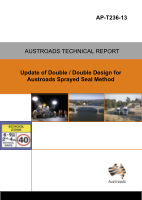Pavement

- Publication no: AP-T236-13
- ISBN: 978-1-925037-06-7
- Published: 14 May 2013
- PDF (free) Download
This document is an update of the design procedure for double/double sprayed seal surfacing. The information supersedes that in Update of the Austroads Sprayed Seal Design Method(Austroads 2006), and replaces Sections 6, 7 and 8 in that document.
These are based on the philosophy of filling voids in the aggregate matrix with binder to a depth of about one-half to two-thirds the height of the aggregate when lying on its least dimension. Adjustments and allowances are incorporated in the procedures to cater for aggregate shape, traffic level, embedment, existing surface texture, hardness of existing surfaces and absorption of binder by either aggregates or the existing substrate.
The design procedures cover double/double seals with Class 170 bitumen, Class 320 bitumen, multigrade binder, polymer modified binder and emulsions.
A preliminary sprayed seal selection table is also included.
- 1. Introduction
- 1.1. General
- 1.2. Design for Little or No Trafficking between Applications
- 1.2.1. Use of Cutter
- 1.3. Design for Second Application Delayed
- 1.4. Selection of Appropriate Double/Double Seal
- 1.5. Aggregate Size Combinations
- 2. Design for Little or No Trafficking Between Applications
- 2.1. General
- 2.2. Design Procedure for First Application
- 2.2.1. Design Procedure
- 2.2.2. Basic Voids Factor for First Application (Vf1)
- 2.2.3. Adjustments to Reduced Basic Voids Factor (Vf1)
- 2.2.4. Design Voids Factor (VF1)
- 2.2.5. Basic Binder Application Rate (Bb1)
- 2.2.6. Allowances Applied to Basic Binder Application Rate (Bb1)
- 2.2.7. Design Binder Application Rate (Bd1)
- 2.2.8. Aggregate Spread Rates
- 2.3. Design Procedure for Second Application
- 2.3.1. Design Procedure
- 2.3.2. Basic Voids Factor (Vf2)
- 2.3.3. Design Voids Factor
- 2.3.4. Basic Binder Application Rate
- 2.3.5. Design Binder Application Rate (Bd2)
- 2.3.6. Aggregate Spread Rate
- 3. Double/double seal with PMB
- 3.1. General
- 3.2. Design for Little or No Trafficking Between Applications
- 3.2.1. First Application Using a PMB
- 3.2.2. Second Application Using a PMB
- 3.2.3. Second Application Using C170, C320, Multigrade Bitumen
- 4. Double/double Seals with Bitumen Emulsion Binder
- 5. Design for Second Application Delayed
- 5.1. General
- 5.2. Aggregate Spread Rate
- References
- Appendix A Preliminary Seal Selection Guide
